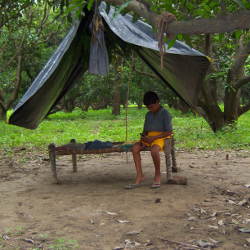
Many teens and college-age students in the developed world are dispensing with computers entirely in favor of smartphones loaded with applications that try to emulate every conceivable task available for a laptop, and then some. But can the same be assumed for educational tasks in developing nations? Could efforts that seek to provide low-cost laptops to impoverished rural communities, such as One Laptop Per Child (OLPC) program, be replaced by efforts to use mobile phones in unsupervised distance learning?
At CHI 2010, the ACM Conference on Human Factors in Computing Systems, a team led by Anuj Kumar, graduate student at Carnegie-Mellon University’s Human-Computer Interaction Institute, presented "An Exploratory Study of Unsupervised Mobile Learning in Rural India," initial findings on tests conducted in the summer of 2008 and 2009, teaching students English as a Second Language in rural villages in the state of Uttar Pradesh in India. While the team took care to point out obvious limitations stemming from factors such as rural power quality in developing nations, and male-female inequities among children in South Asia, the team remains upbeat about the possibilities of learning over mobile phone networks.
Even advocates of inexpensive laptops express support for the efforts. "Certainly, even mid-range mobile phones these days offer a lot of functionality," says Daniel Parkman, a group leader with an OLPC project in Latin America managed through Colorado College (Colorado Springs, CO). "The real issue is the learning environment. In a classroom, a low-cost laptop would offer keyboard and storage advantages. Outside the classroom, a mobile phone could make sense as an aid to homework."
In the CMU study, school-age children in both upper and lower castes were loaned Motorola RAZR V3m phones. Parents in many families already had mobile phones, but the control of the phones by the children allowed a variety of daily learning patterns. In many cases, parents who worried about theft did not allow children to take the phones to and from school.
Overall, significant progress was shown in the ability of students to learn new English words over a period of several weeks, though there was a particular learning spike around the sixth week, followed by a plateau. Most students learned 42 to 46 new words over a span of 16 weeks. The most concrete problem experienced by the researchers was the inability of some children to recharge phones, because their home power supplies were not reliable enough. Kumar says this problem may be rectified over time, as several vendors offer hand-cranked chargers, and Nokia has developed a charger based on bicycle power.
Challenges less amenable to quick fixes are the gender patters reinforced by parents, in which boys have more free time due to the division of household chores, and are also given more access to mobile phones. Nevertheless, the CMU team found that girls made optimal use of their time with the phones. As a result, the team took several requests from subjects’ mothers to offer similar learning programs with mothers. Kumar says that CMU graduate student Geeta Shroff is working on follow-on studies that explore mother-child learning dynamics, with the hope that some aspects of the study can look specifically at learning opportunities for mothers.



Join the Discussion (0)
Become a Member or Sign In to Post a Comment